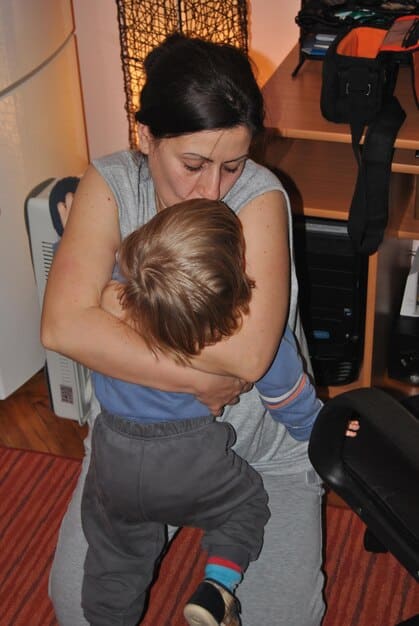Decoding Temperament: Understanding Your Child’s Unique Personality

Unraveling a child’s temperament offers a profound lens into their innate behavioral and emotional patterns, providing insights crucial for tailored parenting strategies, fostering healthy development, and strengthening the parent-child bond, moving beyond one-size-fits-all approaches to truly support individual growth.
Within the intricate tapestry of child development, few concepts are as foundational yet frequently misunderstood as decoding temperament: understanding your child’s unique personality and development. It’s the whisper of individuality, a complex interplay of genetic predispositions and early environmental influences that shapes how a child interacts with the world, expresses emotions, and responds to new experiences. This exploration illuminates the profound significance of recognizing and nurturing these inherent traits, paving the way for more attuned parenting and a child’s thriving journey.
The Core of Temperament: What Exactly Is It?
Temperament, at its heart, refers to the inherent, biologically based behavioral and emotional styles that are evident from birth. It’s not about what a child does, but rather how they do it. Think of it as the ‘how’ of personality—their typical approach to the world, their characteristic mood, activity level, and adaptability. It forms the bedrock upon which personality is built, influenced but not entirely determined by environmental factors and developmental stages.
Understanding temperament is pivotal because it moves beyond simplistic labels like “good” or “naughty” and instead offers a framework for appreciating individual differences in children. It helps parents and caregivers see behaviors not as intentional defiance, but as expressions of an intrinsic way of being. This shift in perspective can dramatically reduce parental stress and conflict, fostering a more harmonious home environment centered on empathy and genuine understanding.
Dimensions of Temperament: A Closer Look
Researchers Alexander Thomas and Stella Chess, pioneers in temperament studies, identified nine key dimensions that help describe a child’s unique make-up. These dimensions are not rigid categories but rather continua, along which each child falls differently, creating an infinite array of temperamental profiles. Recognizing these elements in your child provides a powerful tool for responsive parenting.
- Activity Level: How much a child moves and physically engages with their environment. Some children are naturally high-energy, while others prefer quieter pursuits. Adapting activities to match this energy level can prevent frustration for both child and parent.
- Rhythmicity/Regularity: The predictability of a child’s biological functions, such as hunger, sleep, and bowel movements. A highly rhythmic child thrives on routine, whereas a less rhythmic child may be more flexible.
- Approach/Withdrawal: A child’s initial reaction to new situations, people, or objects. Some children eagerly approach the new, while others show caution and need more time to adjust.
- Adaptability: How easily a child adjusts to changes in routine or environment once the initial reaction has passed. This differs from approach/withdrawal; a child might initially withdraw but adapt quickly once comfortable.
Each of these dimensions contributes to the overall picture of a child’s temperamental style. Knowing these helps parents anticipate reactions and tailor their responses, promoting a sense of security and positive self-esteem in the child.
Mood and Intensity in Temperament
Further dimensions delve into the emotional texture of a child’s temperament. Understanding these aspects can provide insight into how a child expresses their feelings and the overall emotional climate they tend to exhibit. It’s crucial to remember that no single dimension is inherently “better” than another; diversity is natural and valuable.
- Quality of Mood: The child’s predominant disposition—whether generally cheerful, serious, irritable, or positive. This isn’t about fleeting emotions, but their typical baseline affective state.
- Intensity of Reaction: The energy level of a child’s emotional responses, whether positive or negative. Some children react subtly, while others express their feelings with great vigor and drama.
By observing and consciously reflecting on these dimensions, parents can begin to piece together the unique puzzle of their child’s temperament. This awareness isn’t about pigeonholing a child but rather about recognizing their innate tendencies to foster a supportive environment where they can flourish authentically. Building on this understanding allows for more effective communication and disciplinary approaches.
Temperamental Profiles: Beyond the Labels
While every child is unique, temperament researchers often categorize children into broad profiles for easier understanding and application in parenting contexts. Thomas and Chess initially identified three main profiles: “easy,” “difficult” (or challenging), and “slow-to-warm-up.” However, it’s vital to view these as general tendencies rather than rigid boxes, as many children display a mix of traits that don’t fit neatly into one category. These profiles provide a starting point for discussion, but parental observation remains key.
The “easy child” tends to be adaptable, positive in mood, rhythmic in routines, and approaches new situations with curiosity. These children are often a delight to care for, making transitions smoother and generally less demanding. However, even an “easy child” benefits from attuned parenting that recognizes their subtle needs and prevents them from being overlooked.
Conversely, the “difficult” or “challenging child” often exhibits high intensity in reactions, displays a more negative mood, less rhythmicity, and tends to withdraw from new experiences. These children can be more demanding, require more patience, and often challenge parental boundaries. Yet, with understanding and tailored strategies, their intensity can be channeled into passion and persistence.
The “Slow-to-Warm-Up” Child
The “slow-to-warm-up” child presents a unique set of characteristics that blend aspects of both easy and difficult temperaments. Initially, these children tend to withdraw from new situations, showing caution and sometimes mild negative reactions. However, given time and repeated exposure, they eventually adapt, often quite positively. Their key need is for gradual introductions and patience, rather than being rushed into new experiences.
- Initial Hesitation: They may cling to parents in new social settings or observe from a distance before joining in. This is not shyness or defiance, but a temperamental predisposition.
- Need for Familiarity: They thrive in predictable environments and benefit from warnings about upcoming changes, allowing them to mentally prepare.
- Gradual Adaptation: Once they feel secure and have processed a new situation, they can become quite engaged and relaxed. Pushing them too quickly can lead to greater withdrawal.
Understanding these profiles helps parents adjust their expectations and parenting styles. Instead of trying to force a “difficult” child to be “easy,” or a “slow-to-warm-up” child to be immediately gregarious, parents can work with their child’s natural tendencies. This harmony between a child’s temperament and their environment is known as “goodness of fit,” a crucial concept for healthy development.

Goodness of Fit: Harmonizing Temperament and Environment
The concept of “goodness of fit,” introduced by Thomas and Chess, is arguably the most empowering aspect of temperament theory for parents. It suggests that optimal development occurs when there is compatibility between a child’s temperament and their environment, including the demands, expectations, and approaches of their caregivers. When there’s a strong fit, children thrive; when there’s a mismatch (a “poorness of fit”), stress and behavioral challenges can arise.
Achieving goodness of fit doesn’t mean parents must completely change their personalities to suit their child. Instead, it involves a conscious effort to understand the child’s innate tendencies and then adapt parenting strategies, expectations, and the environment to better support those tendencies. This might involve adjusting routines, modifying responses to behavior, or seeking out specific types of activities or social settings that align with the child’s natural inclinations.
Strategies for Promoting Goodness of Fit
Creating a harmonious environment for a child based on their temperament requires thoughtful consideration and flexibility. It’s an ongoing process of observation, adaptation, and empathetic understanding. Here are some key strategies to enhance the “goodness of fit” in various temperamental styles:
- For the High-Activity Child: Provide ample opportunities for physical play and movement. Incorporate active breaks into quiet times. Understand that their constant motion isn’t defiance but a physical need.
- For the Low-Activity Child: Encourage gentle exploration and don’t push them into high-energy activities. Respect their need for quiet focus and offer engaging, less strenuous options.
- For the Less Regular Child: While routines are helpful, be flexible with schedules. Focus on overall predictability rather than rigid adherence to times. Offer choices where possible to give them a sense of control.
- For the “Slow-to-Warm-Up” Child: Introduce new experiences gradually. Provide warnings about transitions. Allow them to observe from the sidelines until they feel comfortable enough to join in their own time.
This approach moves away from a one-size-fits-all parenting model and embraces the beautiful diversity of childhood. By consciously striving for “goodness of fit,” parents can significantly reduce power struggles, foster a child’s self-esteem, and build a stronger, more respectful relationship. It transforms challenges into opportunities for growth and deeper connection.
Temperament vs. Personality: Drawing the Line
While often used interchangeably in everyday conversation, “temperament” and “personality” have distinct meanings in developmental psychology. Temperament is generally considered the raw material, the innate biological foundation, evident from early infancy, that predisposes a child to certain ways of reacting and behaving. It’s largely genetic and stable over time, though its expression can be modulated by experience.
Personality, on the other hand, is a broader, more complex construct that emerges from the interaction between temperament and the environment. It includes temperament but also encompasses learned behaviors, beliefs, values, coping mechanisms, and social skills developed through life experiences, relationships, and cultural influences. Personality is dynamic; it evolves and refines throughout a person’s lifespan.
Think of it this way: temperament is like the engine of a car – its fundamental make, power, and efficiency. Personality is the entire car – the body, interior, color, accessories, and the way it’s driven, all shaped by the engine’s capabilities but customized by choices and experiences. Understanding this distinction helps in recognizing what aspects of a child’s behavior are inherent and what might be influenced by learning or external factors.
The Interplay: How Temperament Shapes Personality
Temperament significantly influences how a child interacts with their environment, which in turn shapes their developing personality. For example, a child with an “easy” temperament might elicit more positive responses from caregivers, reinforcing their positive outlook. A “difficult” child, prone to intense reactions, might encounter more challenges, potentially leading to the development of different coping strategies and social skills.
- Environmental Responses: A child’s temperament influences how others (parents, siblings, teachers) respond to them, creating a feedback loop. A child who is naturally more irritable might receive more frustrated reactions, potentially reinforcing their negative mood if not handled with understanding.
- Choice of Activities: Temperament can guide a child’s preferences for certain activities or environments. A highly active child might gravitate towards sports, while a more persistent child might prefer intricate puzzles, thereby developing specific skills and interests that contribute to their personality.
- Coping Mechanisms: The challenges posed by one’s temperament (e.g., a “slow-to-warm-up” child facing new social situations) encourage the development of unique coping strategies, which are integral to personality.
Ultimately, personality is a rich tapestry woven from the threads of innate temperament and the diverse experiences of life. While temperament provides the initial inclination, nurture and experience mold it into the unique individual we become. Recognizing this interplay helps parents focus on providing environments that best support their child’s temperamental predispositions, allowing their personality to blossom in a healthy and adaptive way.
Practical Strategies for Temperament-Based Parenting
Armed with an understanding of temperament, parents can move from reactive parenting to proactive, intentionally supportive parenting. This involves careful observation, self-reflection, and a willingness to adjust strategies rather than demanding the child adjust completely. The goal is not to change a child’s temperament, but to effectively guide and support them within their unique framework.
One of the most powerful strategies is simply to acknowledge and validate a child’s feelings and reactions, even if they seem intense or challenging. For a child with high intensity, saying “I see you’re feeling very strong about this” before addressing the behavior can be far more effective than immediate reprimand. This validates their internal experience, making them feel understood, even during difficult moments.
Adapting Discipline and Communication
Discipline and communication are areas where temperament-based parenting can make a significant difference. A technique that works for one child might be completely ineffective or even counterproductive for another, depending on their innate characteristics.
- For the Highly Persistent Child: These children may resist transitions or rules they don’t understand. Instead of head-on clashes, explain the “why” behind requests and offer limited choices to give them a sense of control. Avoid power struggles; persistence can be a strength when channeled correctly.
- For the Distractible Child: Provide clear, concise instructions, one step at a time. Minimize distractions during tasks. Break down larger activities into smaller, more manageable parts. Positive reinforcement for focus is particularly effective.
- For the Child with Negative Mood: Acknowledge their feelings without getting caught in the negativity. Help them label emotions (“It sounds like you’re feeling frustrated”). Offer comfort and opportunities to process emotions in a healthy way, rather than trying to cheer them up constantly.
- For the Highly Sensitive Child: Be mindful of sensory input—loud noises, bright lights, scratchy clothes. Create quiet spaces. Use gentle language and avoid harsh tones, as they can be easily overwhelmed.
Moreover, consistent routines, clear expectations, and predictable consequences are beneficial for almost all temperaments, though the degree of rigidity may vary. For example, a less rhythmic child might need flexibility within a general routine, while a highly rhythmic child thrives on precision. The key is thoughtful application, not blind adherence to rules. This approach nurtures self-regulation and resilience.
Temperament and Sibling Dynamics
Understanding temperament is particularly insightful when dealing with sibling relationships. It explains why children from the same family, raised in the same environment, can be so remarkably different. These inherent differences often manifest in contrasting needs and interactive styles, which can be a source of both richness and friction within the family unit. Parents often instinctively compare siblings, but acknowledging their distinct temperaments helps to avoid unfair comparisons and foster individual growth.
For instance, a highly active, expressive child might naturally dominate interactions, while a slow-to-warm-up sibling might struggle to find their voice. A parent aware of these temperamental differences can facilitate more balanced interactions, ensuring each child’s needs are met and their unique contributions are valued. This doesn’t mean treating children identically, but rather equitably, based on their individual make-up.
Navigating Sibling Differences with Temperament in Mind
When temperamental differences lead to conflict or imbalance, parents can intervene with strategies that respect each child’s innate wiring. This promotes understanding and reduces sibling rivalry rooted in differing needs and reactions.
- Avoid Comparisons: Consciously refrain from verbal comparisons. Celebrate each child’s unique strengths and help them recognize their own value independently of their siblings.
- Tailor Quality Time: Recognize that each child might prefer different forms of connection. One might thrive on active play, while another prefers quiet conversation or creative projects.
- Explain Differences: As children grow older, engaging in simple conversations about how “we’re all different and that’s okay” can be powerful. “Your brother needs more time to think before he speaks,” or “Your sister likes to do things very fast, and you like to take your time.”
- Facilitate Compromise: Help siblings understand their own and each other’s temperamental needs when resolving conflicts. Guide them towards solutions that respect variability.
By applying a temperament lens to sibling dynamics, parents can transform potential points of tension into opportunities for mutual respect and appreciation. It helps children understand themselves better in relation to others, building empathy and stronger bonds rooted in acceptance of individual differences.
Long-Term Impact: Temperament Through Adulthood
While temperament is most evident in childhood, its influence extends throughout the lifespan, shaping adult behaviors and preferences. Research suggests that temperamental traits show remarkable stability from infancy through adulthood, albeit with expressions adapting to more complex social and cognitive capabilities. For example, a “slow-to-warm-up” child might become a cautious, reflective adult who carefully considers decisions, while a highly “persistent” child might become a determined, goal-oriented adult.
Temperament does not dictate destiny, but it does set a baseline for how an individual typically approaches the world. An understanding of one’s own temperament, or that of partner and friends, can lead to greater self-awareness and improved relationships. Recognizing these ingrained patterns can help adults choose careers, hobbies, and social environments that better align with their natural tendencies, leading to greater satisfaction and reduced stress.
Temperament, Resilience, and Mental Health
The interplay between temperament and life experiences also profoundly impacts resilience and mental health outcomes. Children with certain temperamental profiles, such as those with high intensity or low adaptability, might be more vulnerable to stress or external challenges if adequate support is not provided. Conversely, positive temperamental traits, like a predominantly positive mood or high adaptability, can act as protective factors.
- Building Resilience: A key aspect of supporting children within their temperamental framework is to foster resilience. For instance, a child prone to withdrawal can be gently encouraged to try new things in small, manageable steps, building confidence and adaptability over time.
- Identifying Vulnerabilities: Understanding temperamental vulnerabilities allows parents and caregivers to provide targeted support. For a highly sensitive child, minimizing overstimulation can prevent anxiety. For a child with intense reactions, teaching emotional regulation strategies from an early age is crucial.
- Promoting Self-Awareness: As children grow, helping them understand their own temperamental traits empowers them. Conversations like, “You seem to get really frustrated when things don’t go perfectly; that’s part of how you’re made, and we can learn ways to manage that,” build self-acceptance and agency.
Ultimately, a deep understanding of temperament empowers parents to tailor their approach, offering the right environment and guidance for their child to navigate challenges and leverage their inherent strengths. This foundational knowledge contributes to well-adjusted individuals who can understand and manage their own unique make-up, leading to greater emotional well-being and success throughout life.

| Key Aspect | Brief Description |
|---|---|
| 👶 Temperament Defined | Innate behavioral/emotional styles from birth, foundational for personality. |
| 🧩 9 Dimensions | Activity, rhythmicity, approach/withdrawal, adaptability, mood, intensity, etc. |
| 🔄 Goodness of Fit | Harmony between child’s temperament and environmental support for optimal growth. |
| 🌱 Temperament vs. Personality | Temperament is innate blueprint; personality is developed through interaction with environment. |
Frequently Asked Questions About Child Temperament
While temperament is largely stable and innate, its expression can be modified and refined by experience and conscious parenting. A child won’t fundamentally change their core temperament, but they can learn coping strategies and adaptive behaviors to manage their innate tendencies more effectively as they grow, influenced by environment.
Understanding temperament allows for tailored discipline strategies. For example, a highly intense child might need calm-down techniques, while a persistent child might require clear explanations and choices. It helps parents see misbehavior less as defiance and more as temperamental expressions, leading to more empathetic and effective responses.
Absolutely. A child’s approach/withdrawal dimension greatly influences how they interact with peers and new social situations. A “slow-to-warm-up” child might need more gentle encouragement in social settings, while an “easy” child might naturally gravitate towards social play, impacting their friendship formation and social comfort.
Yes, a “poorness of fit” occurs when there’s a mismatch between a child’s temperament and their environment, including parental expectations. For instance, a parent who values quiet study might struggle with a naturally high-activity child. Recognizing this mismatch is the first step towards adjusting expectations and strategies for better harmony.
The nine dimensions identified by Thomas and Chess are: Activity Level, Rhythmicity (regularity), Approach/Withdrawal, Adaptability, Intensity of Reaction, Quality of Mood, Attention Span and Persistence, Distractibility, and Sensory Threshold. These help describe a child’s unique behavioral and emotional style.
Conclusion: The Empowering Journey of Understanding
The profound journey of decoding temperament: understanding your child’s unique personality and development is not merely an academic exercise; it’s a transformative approach to parenting and child development. By peeling back the layers of behavior to reveal the innate tendencies beneath, parents gain a more compassionate and effective lens through which to view their children. This understanding fosters “goodness of fit,” reducing friction, enhancing communication, and ultimately nurturing a child’s inherent strengths, leading to greater self-esteem and resilience. It’s an invitation to celebrate individuality, to parent with intention, and to build a harmonious family environment where every child feels truly seen, understood, and cherished for precisely who they are, setting the stage for a lifetime of well-being and genuine connection.





